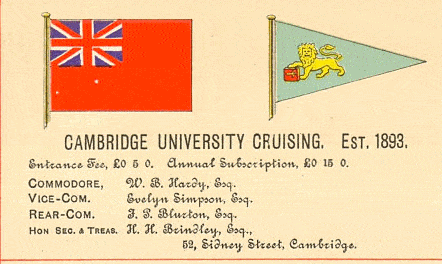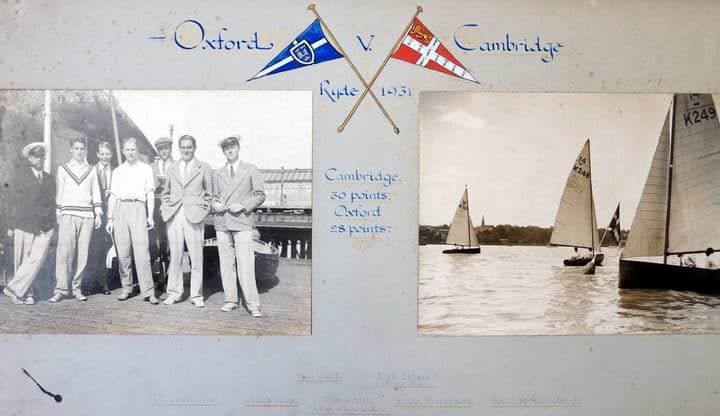A Brief General History of the Club


Beginnings of Cambridge Sailing Windsurfing Kitesurfing History
Dons whose main interest was in cruising formed the CUCrC on 20th May 1893. They chose the name ‘Cambridge Cruising Club’ initially. This changed almost immediately, on 27 May 1893, to ‘Cambridge University Yachting Society’, and changed again, on 6 February 1894, to ‘Cambridge University Cruising Club’. The Club paid little attention to undergraduates at first, unless they happened to own a large yacht. In spite of this, Club members were sailing Sharpies on the Ouse at St Ives by 1898/99. Around the same time the Committee was mentioning the need to: “bring the Club to the attention of freshmen”. So commenced Cambridge sailing windsurfing kitesurfing history.
Club Room
At first the Club used the college rooms of officers as a library and for social interaction. In 1930 the Club established its first clubhouse in Ram Yard. From that time the Club had a clubhouse continuously until the re-development of Falcon Yard in 1972. In the 1970s and 80s the great improvement in college social facilities, resulting from gender liberalisation, made a club room obsolete. The electronic communication revolution also contributed to this obsolescence, with an identical outcome occurring at Oxford.
Students Get Involved as Well as Alumni
In 1901 the Club expressed the hope that an undergraduate would be elected Rear Commodore. However, it was not until 1921/22 that the Club started electing a Junior Head of the Club annually. Right from the late 1890’s there was considerable student Cambridge sailing as well as ‘big-boat yachting’ at coastal locations. There was also a sizeable London membership and some fears of a possible split were expressed at the time! Early sailing was all within the Club, apart from the annual Varsity Match with Oxford, which started in 1912.
Team Racing
The Varsity Match restarted on an annual basis in 1920 after the World War I – a full history will be found on the O&CSS website. An annual Cuppers competition was initiated in 1924. However, it was not until the mid-1930s that external matches with other clubs started. The first match with another ‘university’ was against United Hospitals (UH) in 1935, which UH won. Cambridge medics did their clinical training in London until 1976, so there were several ex-Cambridge sailors on the UH team. The Club first sailed against University College, London in 1947, Imperial College, London in 1948, Trinity College, Dublin in 1949, and London University in 1950. All these matches were won by Cambridge. See Wikipedia for a history of team racing.
The Club initiated an annual invitational team racing event, the Cam Cup, in 1999 – for the best student and alumni teams in the country. But the major focus of UK university ambitions remains the British Universities Sailing Association (BUSA) team racing championships, with its round of regional qualifiers and subsequent national finals. Historic Cambridge BUSA results are available on this website, along with Cuppers and Cam Cup results.
Sailing Waters
In Cambridge sailing, windsurfing, kitesurfing history the question of suitable sailing waters remained a major issue over the years. Sentiment first favoured the Ouse, using locations at Godmanchester, Houghton Mill, Ely, Waterbeach, and St Ives.
In addition to the river, the Club used gravel pits at St Ives in the 1960’s. The Club’s only known fatal accident took place at St Ives in February 1950. The river, which was in flood, swept R E Thomas of Selwyn under the St Ives bridge. He could nor swim, was not wearing a life jacket and, most unfortunately, drowned. Modern Health & Safety regulations and practices were yet to be established.
Grafham Water appeared in 1968 and the Club made much use of it. This use extended to running residential training courses at the Grafham Sailing Centre in 1970. Furthermore, Club members constructed several kit Enterprises around that time. Indeed, Elisabeth Nodder (née Jory – Selwyn 1977) is still sailing one such Enterprise at her home club! Hunts SC set up on a St Ives gravel pit in the early 1970s, and the Club used Hunts as a winter alternative to Grafham.
Windsurfing Arrives
Carol Chisholm, who was an International Windsurf Instructor when she came up to Sydney Sussex to read Mathematics in 1977, initiated Cambridge windsurfing. She persuaded the Club to buy three Ten Cate Mark 1 Windsurfers with their wooden booms and stainless steel universal joints. A sample version of this very early windsurfer is now in the National Maritime Museum). Carol, with the help of Nick Bion (Churchill 1976) and car-owner Jerry Marshall (Caius 1976), started windsurfing on the St Ives gravel pit. Windsurfing had in fact been slowly dawning on the Cambridge scene. Just before Carol arrived, Bruce Burnett (Corpus Christi 1975) led a group to try out these new-fangled things at Poole Harbour. Bergasol, the suntan lotion people of the time, organised the trial at Sandbanks in the summer of 1977.
Milton Pit Days in Cambridge Sailing, Windsurfing, Kitesurfing History
Milton Pit became available in 1979, within a bicycle ride of Cambridge, and was used intensively until 1985. Windsurfing benefited particularly from Milton’s proximity to Cambridge. However, the Milton arrangements were not totally secure. The erection of a tall industrial building at the south west corner of the pit put an end to all sailing activity there. The Club reverted to using Grafham, Hunts, and Waterbeach for its activities, focusing solely on Grafham Water since October 2013.
Yachting Expands
Renewed interest in student ‘big boat’ sailing arose in the 1980’s, although a scheme for matching student crews with owners had been in existence for many years. This renewed ‘big boat’ interest reflected the decline of dinghy sailing in general and the availability of inexpensive easily-maintained fibreglass cruising boats. In addition, demographic changes in the University meant that there were more people interested in, well, cruising! Currently Cambridge has 3,500 post-doctoral researchers, 6,800 PhD students, and 12,200 undergraduates. Furthermore, university staffing has expanded to match these numbers.
Hywel Room (Downing) initiated significant ‘big boat’ activity in 2001. As a result, by 2012 the Yachting Section was over 200 strong and owned two cruisers. In that year the Section decided to separate and, on 25th March 2013, became the Cambridge University Yacht Club. The terms of the separation were specified in a so-called Compromise Agreement.
Women’s Sailing in Cambridge Sailing, Windsurfing, Kitesurfing History
The emancipation of women’s sailing mirrored the stately progress of this matter at Cambridge in general. The first admission of women to men’s colleges did not take place until October 1972. The earliest mention of ‘sailing women’ was in 1953, when a move to admit them to CUCrC membership was rejected. Then, at the instigation of Tim Eiloart (Trinity 1955), women formed the Cambridge University Women’s Sailing Club in 1955/56. Hilary Fischer-Webb (now Weeks, Newnham 1955) was Rear Commodore for her three years – followed by her sister Daphne (now Boddington, Newnham 1958) for 1959-61. (Daphne gained national distinction by being the first woman to win a major championship race – at Redwing Week.)
In 1956 it was proposed that the CUWSC might affiliate to the CUCrC in 1961. In fact, by 1958 it had been agreed that CUWSC members could take part in all CUCrC activities. As a result there was a Womens Race at the Inland Regatta of June 1959. There was also a formal ‘sharing’ agreement drawn up in June 1959, which was ratified in November 1959 at the CUCrC AGM. The CUWSC merged with the CUCrC in 1967/68, five years before the start of Cambridge college gender liberalisation.
Kitesurfing
In 2018, on the initiative of Matt Ashman (St Johns), the Club agreed to act as a focal point for kitesurfers at Cambridge. Earlier attempts around 2012 to organise Cambridge kitesurfing did not take root. Current efforts have also yet to bear fruit, but work continues.
Contributions to the Sport and Environment
As well as many successes in national and international events, club members have made major contributions to the sport and environment in general. The links in this paragraph are mainly to the Wikipedia article on the person or item concerned. George Cockshott designed the ‘International’ 12 Foot Dinghy , which is still raced competitively. Geoffrey Taylor (later Sir Geoffrey and President of the Club for 1946-60) invented the CQR anchor. Stewart Morris founded the Oxford & Cambridge Sailing Society in 1934, and it was instrumental in promoting team racing in the UK and internationally.
Peter Scott (later Sir Peter) added to his sailing successes by becoming a champion of wildfowl preservation and painting – and also found time to be President of the IYRU (now World Sailing) for 1955-69. Air Commodore Charles Nance played a role in the investigation of rotor ships in the 1980’s (see Windship Technology, Editor: C Satchwell, Elsevier 1985, eBook ISBN 9780444601520). Ian Walker, who led the winning team in the 2014/15 Volvo Ocean Race amongst other successes, now heads yachting development at the UK Royal Yachting Association. This section is limited and eclectic -a great many other members who are not mentioned have made major contributions to business, public and armed services life.
The Role of Cambridge Sailing, Windsurfing, Kitesurfing History in the Origin of the Firefly Dinghy
One of the more interesting byways of Club history concerns the Firefly dinghy, now the standard boat for university and school team racing in the UK. In 1939 Uffa Fox designed a 12 foot dinghy for Cambridge called the ‘Sea Swallow’, which was overtaken by the outbreak of World War II. However, post-war, when Sir Richard Fairey wanted a boat to hot mould in his soon-to-be-redundant aircraft autoclaves, Uffa sent him the pre-war drawings. Uffaa famously scribbled out the ‘Cambridge Sea Swallow’ title and replaced it by ‘Fairey Firefly’. The Firefly Class website records the full history of the Firefly dinghy.
Other History Sources
Wikipedia has a good general history of team racing. The University Library houses the full archives of the Club. Use this CU Library link to access details of what is available. The index to the archives is hierarchical and it is possible to drill down several levels.
An excellent history of the Tozer Cup by David Knight is available on this website. This is a large (5Mb) PDF file, but it contains a good many interesting photographs, so it is worth waiting for the download. Page 11 contains an account of the Anglo-Swiss team racing on Lake Thun in 1939 (won), and Page 14 an account of Iain Macdonald-Smith’s Gold Medal win in the 1968 Olympics.
